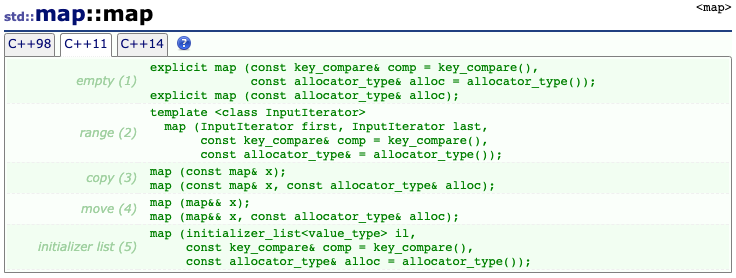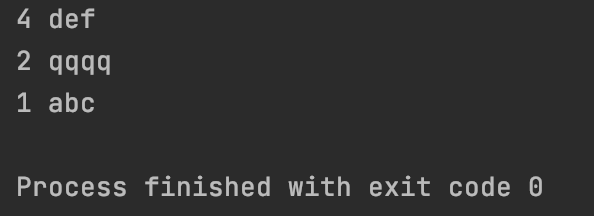 【C++&Leetcode】自定义排序的方法与辨析
【C++&Leetcode】自定义排序的方法与辨析
# 关于map自定义排序的问题
在使用C++刷Leetcode时,常常会使用有序容器,如map、set等。同时也会用到例如sort这类排序函数。
通常来说,我们知道写lambda表达式或者函数来自定义sort。也会写struct并重载调用运算符来自定义map,set。但是它们究竟有什么区别,又有什么联系?
本文会简析常见的自定义排序方法,并说明它们的区别和联系。
# 1. std::sort()如何自定义排序
为了弄清楚有多少种方式,首先去cplusplus.com中关于sort的文档 (opens new window)去看一看具体的描述:

sort是一个模板函数,传进去的首先是对相应的容器迭代器,然后是有关自定义排序的Compare comp,我们来看对它的描述:
comp
Binary function that accepts two elements in the range as arguments, and returns a value convertible to
bool. The value returned indicates whether the element passed as first argument is considered to go before the second in the specific strict weak ordering it defines. The function shall not modify any of its arguments. This can either be a function pointer or a function object.
这里就也很明确的说:comp是一个函数指针或函数对象。
官方给出的代码:
// sort algorithm example
#include <iostream> // std::cout
#include <algorithm> // std::sort
#include <vector> // std::vector
bool myfunction (int i,int j) { return (i<j); }
struct myclass {
bool operator() (int i,int j) { return (i<j);}
} myobject;
int main () {
int myints[] = {32,71,12,45,26,80,53,33};
std::vector<int> myvector (myints, myints+8); // 32 71 12 45 26 80 53 33
// using default comparison (operator <):
std::sort (myvector.begin(), myvector.begin()+4); //(12 32 45 71)26 80 53 33
// using function as comp
std::sort (myvector.begin()+4, myvector.end(), myfunction); // 12 32 45 71(26 33 53 80)
// using object as comp
std::sort (myvector.begin(), myvector.end(), myobject); //(12 26 32 33 45 53 71 80)
// print out content:
std::cout << "myvector contains:";
for (std::vector<int>::iterator it=myvector.begin(); it!=myvector.end(); ++it)
std::cout << ' ' << *it;
std::cout << '\n';
return 0;
}
2
3
4
5
6
7
8
9
10
11
12
13
14
15
16
17
18
19
20
21
22
23
24
25
26
27
28
29
30
31
32
这里面比较重要的是:
- 6行定义的函数,在20行被直接传进去参数使用了。
- 8-10行定义的结构体
myclass受限实例化了一个对象myobject。然后在23行时,myobject被拿来作为参数传进了sort里。
也就是说,自定义sort有两种方法
可以自定义一个bool型函数,里面的大小规则要是严格弱序的,然后把这个函数名作为参数传给sort。
除此之外,我们还可以写一个struct或者class,注意要在这个结构体or类中重载调用运算符。然后利用这个结构体or类去实例化一个对象,也就是所谓的函数对象。把这个函数对象传递给sort也可以完成自定义排序。
那我们常见的lambda表达式自定义排序的方式属于哪一类呢?实际上lambda表达式本身就是一个函数对象,它免去了建立结构体或类,然后实例化的过程。通常为了自定义排序所建立的结构体或类也不被调用多次,而lambda表达式大大简化了利用函数对象的步骤,所以常常在一些自定义排序的过程中见到。
# 2. std::map<>如何自定义排序:
为了说清楚map能如何自定义排序,我们还是要去看一下详细的文档。在cplusplus.com中map容器模板 (opens new window)的描述如下:

首先需要注意到,前面的std:sort()是一个模板函数,而这个std::map是一个模板类。这是本质区别,同时也导致了自定义排序的一些不同。在模板参数中,有一个重要的class Compare是需要关注的重点,文档关于它的描述如下:
Compare
A binary predicate that takes two element keys as arguments and returns a
bool. The expressioncomp(a,b), where comp is an object of this type and a and b are key values, shall returntrueif a is considered to go before b in the strict weak ordering the function defines. Themapobject uses this expression to determine both the order the elements follow in the container and whether two element keys are equivalent (by comparing them reflexively: they are equivalent if!comp(a,b) && !comp(b,a)). No two elements in amapcontainer can have equivalent keys. This can be a function pointer or a function object (see constructor (opens new window) for an example). This defaults toless<T>, which returns the same as applying the less-than operator (a<b). Aliased as member typemap::key_compare.
看粗体部分可以发现,我们需要一个comp(a, b)来控制数据的顺序,而这个comp就是Compare类的对象。看到这里,我们就发现了前后的联系:又是函数对象!
接着来看一下map的构造函数 (opens new window)怎么声明的:

在map容器的构造函数中又一次出现了comp,对于这个形参的描述,cplusplus.com文档继续描述如下:
comp:
Binary predicate that, taking two element keys as argument, returns
trueif the first argument goes before the second argument in the strict weak ordering it defines, andfalseotherwise. This shall be a function pointer or a function object. Member typekey_compareis the internal comparison object type used by the container, defined in map (opens new window) as an alias of its third template parameter (Compare). Ifkey_compareuses the default less (opens new window) (which has no state), this parameter is not relevant.
看到这里,我们就明确了comp可以是两种类型:(1)函数指针,(2)函数对象。
这就很巧了,前面std::sort()也是这两点,那它们实际使用的时候会有什么区别呢,还是说完全一样?下面来看cplusplus给出的两种方法的实例:
// constructing maps
#include <iostream>
#include <map>
bool fncomp (char lhs, char rhs) {return lhs<rhs;}
struct classcomp {
bool operator() (const char& lhs, const char& rhs) const
{return lhs<rhs;}
};
int main ()
{
std::map<char,int> first;
first['a']=10;
first['b']=30;
first['c']=50;
first['d']=70;
std::map<char,int> second (first.begin(),first.end());
std::map<char,int> third (second);
std::map<char,int,classcomp> fourth; // class as Compare
bool(*fn_pt)(char,char) = fncomp;
std::map<char,int,bool(*)(char,char)> fifth (fn_pt); // function pointer as Compare
return 0;
}
2
3
4
5
6
7
8
9
10
11
12
13
14
15
16
17
18
19
20
21
22
23
24
25
26
27
28
29
30
31
上面的代码中,比较重要的是:
- 第5行的函数,在27行被用函数指针指向。紧接着,在28行这个函数指针被用来构造名为
fifth的map。(实际上直接传函数名也是可以的) - 第7-10行的结构体,在25行被用来构造名为
fourth的map。
通过上面的代码来看,确实是两种自定义的方式,一个是利用函数指针,另一个是用函数对象。那为什么没见过用lambda表达式来自定义排序的呢?根本原因在于,map不仅需要函数对象or函数指针,还需要模板参数(函数对象的结构体or类,或者函数指针的类型)。
具体原因是,map底层是红黑树实现高效的排序。在map实现时,需要传进去那个“重载了调用运算符的结构体or类”来去构造红黑树,而红黑树本身也是一个模板类。因此,自定义排序要在模板参数里传入已经重载调用运算符的结构体或者类(而不是在某个地方传入实例化的函数对象)。使用“函数对象”这种方式时,就不需要再传入其他参数了,因为构造函数可以直接默认构造一个对象去使用。
而如果使用函数指针,则需要在模板参数和构造函数参数里都传入参数,前者是函数指针的类型,后者是函数指针。原因是编译器没办法通过一个函数指针的类型,来推断这个函数的内容。
那我们不使用lambda表达式自定义map排序的原因就是,lambda表达式是一个临时的函数对象,它没有上层的类实现,因此没办法传进去一个模板参数(但是其实也可以用lambda自定义map顺序,后面会说明)。
# 3. 使用lambda表达式自定义std::map<>排序
由于sort()不需要使用自定义类,而是直接使用函数对象就可以了。所以我们使用lambda表达式会很方便。lambda表达式写出来就已经是函数对象了,而重载调用运算符后的struct(或class)还需要实例化后才是函数对象。
不过,使用lambda表达式来自定义map的排序规则也是可以的,因为可以把函数对象当做函数指针来用。lambda表达式本身是一个函数对象,如果对map<int, int>来排序,它的类型就是bool (*)(int, int),类似函数指针的写法,如下例:
auto cmp = [](int lhs, int rhs) { return lhs > rhs; };
map<int, string, bool (*)(int, int)> mp(p_cmp_func);
2
实际上也是可以编译通过的。稍微测试一下:
#include <iostream>
#include <map>
#include <string>
using namespace std;
int main() {
auto cmp = [](int lhs, int rhs) { return lhs > rhs; };
map<int, string, bool (*)(int, int)> mp(cmp);
mp[1] = "abc";
mp[4] = "def";
mp[2] = "qqqq";
for (auto i = mp.begin(); i != mp.end(); ++i) {
cout << i->first << " " << i->second << endl;
}
}
2
3
4
5
6
7
8
9
10
11
12
13
14
运行结果:

所以也是能运行的。
# 4. 小结
下面进行总结:
- 函数指针可以用来为sort或map的自定义排序。sort只需要函数指针(或函数名),map不仅需要函数指针(或函数名),还需要在模板参数里写明函数指针的类型。
- 函数对象可以用来为sort或map进行自定义排序。sort只需要传函数对象,map需要的则是构建函数对象所需的类或结构体。
- 可以用lambda表达式为sort或map进行自定义排序。sort的自定义很简单,直接传入lambda表达式即可。为map自定义排序时不仅需要lambda表达式,还需要像函数指针一样,说明其类型。
# 5. 题外话:std::map<>如何按value排序
前面所提到的map排序都是按照key排序,那怎么样才能按照value排序呢。
思路很简单:可以把map装进vector<pair<>>里,然后对这个vector自定义sort就可以了。
举个简单的例子:
#include <iostream>
#include <map>
#include <vector>
using namespace std;
int main() {
map<int, string> mp;
mp[1] = "abc";
mp[4] = "def";
mp[2] = "qqqq";
cout<<"排序前"<<endl;
for (auto i = mp.begin(); i != mp.end(); ++i) {
cout << i->first << " " << i->second << endl;
}
cout<<"排序后"<<endl;
vector<pair<int, string>> vec(mp.begin(), mp.end());
sort(vec.begin(), vec.end(), [](pair<int, string> lhs, pair<int, string> rhs){
return lhs.second > rhs.second;
});
for (auto x : vec){
cout<<x.first << " " << x.second << endl;
}
}
2
3
4
5
6
7
8
9
10
11
12
13
14
15
16
17
18
19
20
21
22
运行结果:
